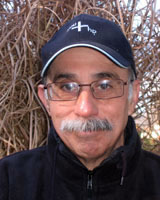Edward R. Landa (USA)

Name: Edward R. Landa
Age: 62
Position: Ground Water Geochemistry Research Group, U.S. Geological Survey, Reston, Virginia (1978-present)
Adjunct Professor, Department of Environmental Science and Technology, University of Maryland, College Park (2010-present)
Address: USA
E-mail:
1. When did you decide to study soil science?
I was a junior in college, majoring in geology, in1968. I had, until then, only a rudimentary knowledge of soils from classroom discussions of weathering. The existence of soil science as a field of study was unknown to me. While taking a class in mineralogy, I read a recent paper in Science by clay mineralogist Charles Rich of the Agronomy Department at Virginia Polytechnic Institute [Brown, JL, Rich, CI (1968) High-resolution electron microscopy of muscovite. Science 161:1135-1137]. I found the kind of varied and highly dynamic systems described here —of frayed edges, interlayers, and ion ex-change— to be of real interest. With that in mind, and wanting some exposure to the field of soil science, I got a summer job at the Charles Lathrop Pack Forest in the south eastern Adirondack Mountains of New York, working with Dr. Albert Leaf (Ph.D., soil science, University of Wisconsin) of the State University College of Forestry. The project looked at factors influencing the growth of red pine on a soil developed on outwash sand. That summer-of-1969 experience, crystallized in my mind by the Apollo 11 moon landing, set me on the path to a career in soil science.
2. Who has been your most influential teacher?
Without a doubt, it has to be Dr. Robert G. Gast of the Department of Soil Science at the University of Minnesota. Bob came to Minnesota to join the faculty in soil mineralogy/chemistry just before my arrival as a new graduate student in the summer of 1970. I did my MS work on the characterization and adsorptive properties of ferric oxides and hydrous oxides, and Ph.D. work on the behavior in soils and plants of the long-lived fission product technetium-99, under Bob’s guidance. Bob went on to become the Vice President of Research and Graduate Studies at Michigan State University before retiring in1998. Sadly, Bob passed away last year. I will always remember his scholarship, mentorship, and personal example.
3. What do you find most exciting about soil science?
Much of my work at the U.S. Geological Survey has focused on uranium mill tailings, the waste rock left after uranium extraction from the ground ore. Once deposited on the land surface, soil-forming processes, superimposed on minerals created in the milling circuit, govern the evolution of these tailings. Training in soil science thus provides a unique lens for examining the biological, physical, and chemical processes controlling the mobility of contaminants from such materials. The dynamism and multi-faceted nature of what C.C. Nikiforoff called the “excited skin of the earth’s crust” is what I find exciting about soils (& soil-like materials) and their study.
4. How would you stimulate teenagers and young graduates to study soil science?
As practitioners in an inherently interdisciplinary field, I think soil scientists view the environment in a holistic way, and tend not to see formal disciplinary boundaries as limiting what is within our grasp for investigation. Although we may occasionally visit silos in our work, “silo thinking” in which there is limited communication, cooperation and under-standing across such boundaries is generally not part of our make-up. I recently joined the faculty of the Department of Environmental Science and Technology at the University of Maryland. This has been an invigorating experience for me, and I thank the graduate students and faculty for the chance to be a part of the activity here. Our department (http://agnr.umd.edu/depart-ments/enst/) has a tremendous breadth of research underway—ranging from ecological technology de-sign & engineering and environmental & ecological health, to wetland science and soil science. It creates a unique learning community where the sum is truly greater than the parts. I think that such intellectual diversity, supported by a shared ecological framework, can be appealing to students, and that its presence can enhance recruitment to soil science. Within that broader setting, I also believe that students will find the tight-knit nature of our soil science community to be appealing. As a student coming from another discipline, I felt that immediately when I attended my first SSSA meeting in 1970, and that sense has stayed with me ever since. I hope that such a human component is part of the personal message we convey when discussing our field of study with students and potential recruits.
5. How do you see the future of soil science?
The traditional employment bases of soil scientists are changing, and this flux can be often be disconcerting. My hopes are that:• As our students move out into perhaps non-traditional positions, they will maintain their core self identity as soil scientists, and continue to see the soil science societies as their prime professional affiliation and disciplinary base.• We all will be active participants, not pessimistic bystanders, in the future changes in soil science. Each of us needs to get out and actively spread the message of the importance of soils in a sustainable future for Planet Earth, and of soil science as a player in that future.




